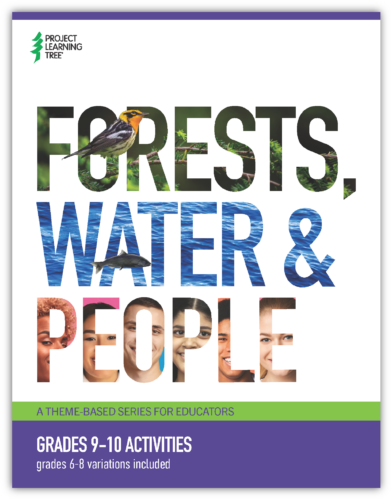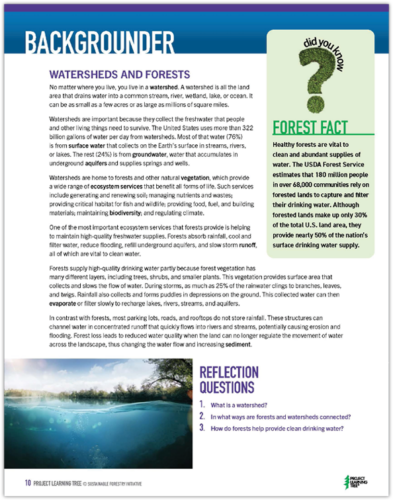 Forests, Water & People – PLT’s Newest Activity Collection!
Forests, Water & People – PLT’s Newest Activity Collection!
Have you ever wondered the source of the water you use for drinking, cooking, or bathing? What happens when water travels through the forest and to our faucets?
Project Learning Tree’s newest downloadable activity collection includes three place-based lessons that examine the connections between forests and watersheds while investigating their impacts on communities.
PLT and the USDA Forest Service collaborated to create a special digital activity collection – Forests, Water & People. The lessons are designed for educators to use with learners in grades 9-10, with variations for grades 6-8.
Grade 9 & Grade 10 Activities
 The three downloadable activities invite students to investigate the relationship between forests and watersheds as they investigate the source of their own drinking water. These hands-on and place-based learning opportunities also incorporate technology to study our environment.
The three downloadable activities invite students to investigate the relationship between forests and watersheds as they investigate the source of their own drinking water. These hands-on and place-based learning opportunities also incorporate technology to study our environment.
- From Tap Root to Tap Water: Students use maps to identify local watersheds and forest cover, evaluating the extent to which their community’s water supply depends on forests.
- Mapping Your Community Through Time: Students investigate the history of their community and make map overlays to look for patterns in how its housing, water systems, and green spaces have changed over time and in relation to each other.
- Watershed Watch: Students examine different perspectives on a community issue related to forests and watersheds, and plan to take action on a local watershed issue.
What’s in a Watershed
No matter where you live, whether you’re in an urban or rural area, you live in a watershed. A watershed is the land area that drains water into a common stream, river, wetland, lake or ocean, and we all rely on these watersheds for our freshwater drinking sources.
In this activity collection, learn more about how forested watersheds are critical sources of high-quality drinking water.
Learning Progressions
Storylines provide connections and continuity to individual activities and can serve as the instructional “glue” that holds areas of knowledge and skills together. The activities in Forests, Water & People may be linked together into a unit of instruction using a storyline, as in the example that follows.
Guiding Question: What is the relationship between forests and drinking water?
Storyline: Students investigate the role of forests in providing their community’s drinking water.
The sequence of individual activities supports this storyline:
- From Tap Root to Tap Water
Introduce the concept of watersheds as a critical source of drinking water, and challenge students to map out their local watershed, indicating the location of any forestlands. Familiarize them with the Forests to Faucets 2.0 tool (see the Exploring the Forests to Faucets 2.0 backgrounder) to further deepen their knowledge about their watershed.
- Mapping Your Community Through Time
Explore how a local community has changed over time in terms of its housing, water systems, and green spaces, including forests. Encourage students to look for ways that changes in these community components are connected.
- Watershed Watch
Invite students to explore a forest-related watershed issue from different stakeholder perspectives, and then to plan and conduct an action project that helps resolve a local watershed problem or maintain local water quality.
New Features within Each Activity
In addition to the typical elements that educators have come to rely on from PLT, the following new features in our theme-based series will further help educators adapt the activities for specific groups and settings.
 Ties to UN Sustainable Development Goals
Ties to UN Sustainable Development Goals
You’ll still find correlations with national academic standards for science, English language arts, and social studies, but in this activity collection, we’ve added ties to the United Nations’ Sustainable Development Goals (SDGs). These 17 goals were adopted by all UN members in 2015 in an effort to “improve health and education, reduce inequality, and spur economic growth – all while tackling climate change and working to preserve our oceans and forests.” Learn more about how PLT activities support UN SDGs.
 Forests to Faucets 2.0 Toolbox
Forests to Faucets 2.0 Toolbox
In each activity, you’ll find a special Toolbox section. Using the Geographic Information System (GIS) mapping tool, Forests to Faucets 2.0, created by the USDA Forest Service, learners explore watersheds in their own communities. You’ll be able to see why sustainable forest management is vital to maintaining quality drinking water supplies.
 Backgrounder
Backgrounder
New to this collection are “Backgrounders”, which highlight relevant information on activity topics. You’ll find helpful things like key vocabulary terms and ways to engage students in each activity.

Purchase Forests, Water & People from PLT’s Shop for $12.99

